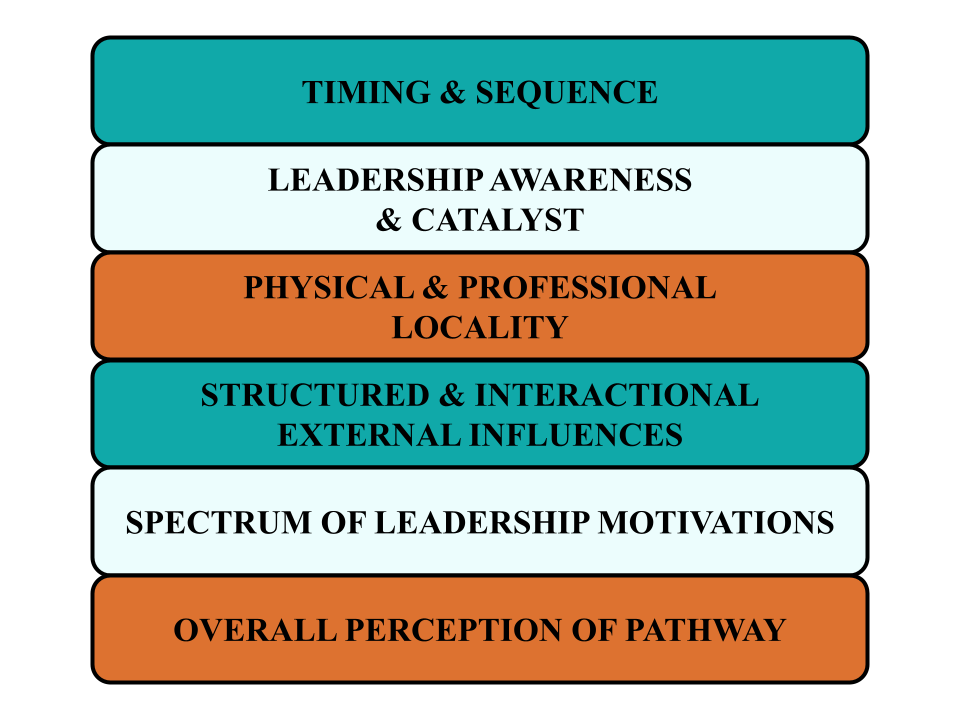Diverse Pathways
into
Leadership in
World Language Education
by Cal Jordan Powers & Dr. Kathleen M. Bailey
The goal of this publication was to define a framework through which we could analyze the careers of leaders working in World Language Education (WLE). This page summarizes the framework introduced in this chapter. If you want to read about the respondents’ pathways, buy the book here.
Powers, C.J., & Bailey, K. M. (2023). Diverse Pathways into Leadership in World Language Education. In Language Teacher Leadership: Insights from Research and Practice (pp. 39-74). Cham: Springer International Publishing.
“It seemed like there was no pathway for classroom teachers to leadership.”
––R-226
Research Questions
When conceptualizing our study, we viewed leadership like a kind of journey, which led us to the metaphor of a pathway. We eventually developed the following research questions:
When analyzing our data, we identified six characteristics of a leadership pathway:
the timing and sequence of experiences; any catalysts that caused individuals to first act on their leadership potential; the locality, or context, in which the work took place; any external influences the leaders received; the leaders’ motivations regarding their [past or] current responsibilities and/or future roles; and the individuals’ overall perception of their pathways. Each characteristic is multifaceted, complex, and dynamic. (p. 45)
“When did our respondents start serving as leaders?
When and how did they become aware of their leadership potential?
When did they first act on their leadership potential?
What was the catalyst, if any, that caused them to first gain awareness of their leadership potential?
What are the diverse pathways into leadership into world language education?
What are the characteristics of the respondents’ experiences of becoming leaders in WLE?
What external influences and/or support, if any, have the respondents had throughout their experiences of becoming leaders?
What were the respondents’ motivations, if any, behind taking on leadership responsibilities?
How did the respondents view their leadership experiences after the fact?”
(pp. 41–42).
The Six Characteristics of a Leadership Pathway
1
Timing & Sequence
We asked our respondents about the timing of when they first began working in leadership roles, both professional experiences and youth leadership experiences, like participation in the Girl Scouts or school clubs.
Based on our respondents’ answers, we outlined five different time zones of the beginning of a leadership pathway:
A. Youth––the years from birth until high school graduation.
E. Childhood––a more specific time zone after infancy and before high school.
B. Undergraduate and Graduate Studies––the years spent earning professional degrees.
C. Beginning Professional Years––the first five years of a professional’s full-time work.
D. Established Professional Years––the years after those first five years working full-time.
2
Leadership Awareness & Catalyst
We also asked our respondents about their leadership awareness catalyst:
Awareness Catalyst––the “culmination of instigating factors that substantially contribute to an individual’s leadership awareness” (p. 47).
We identified two levels of awareness catalysts:
Macro Awareness Catalysts––the “event leaders identify as being the defining moment to their gaining awareness” (p. 48).
Micro Awareness Catalysts––the “incremental influences” that “may eventually reach a tipping point, causing individuals to fully gain awareness of their potential” (p. 48).
We found five types of awareness catalysts:
Self-Generated Awareness Catalysts––an “instigating idea, trait, or experience originating from within the individual that ignites or contributes to leadership awareness” (p. 48).
Other-Generated Awareness Catalysts––an “influence outside the individual that triggers or contributes to leadership awareness” (p. 49).
Experiential Awareness Catalysts––the “processes or time periods in which an individual gains leadership awareness” (p. 50).
Mixed Awareness Catalysts––catalysts that are complex and can not be uniquely labeled as only one of the previous types.
No Identifiable Awareness Catalyst––when an individual works in a leadership role but “did not identify a catalyst that sparked their leadership awareness, had not thought of their leadership awareness, or were unsure if they had experienced a catalyst” (p. 52).
We asked our respondents about the timing of when they first gained leadership awareness, meaning:
Leadership Awareness––an “individual’s initial realization of their own potential to perform successfully in leadership responsibilities” (p. 45).
3
Locality
We wanted to be able to pinpoint exactly where in the world and where in the profession any given professional works so we defined two types of locality:
Physical Locality––the geographic region(s) in which the professional has served.
Professional Locality––the specialization sectors of a profession, such as “academic, associational, committee, conference, teacher education, research, publishing, governmental, and private” (p. 53).
4
External Influence
We sought to understand what kinds of external influences might have impacted our respondents, and as these influences “can be more or less structured and may arise serendipitously through interaction,” (p. 56) we defined such structures as:
Structured Influences––the professional development “initiated to provide leadership information, skills training, and/or guidance in an organized, goal-oriented, possibly time-bound way, and often requires participation and motivation” (p. 56).
Interactional Influences––the “reciprocal interactions with other individuals, often unplanned and possibly not goal oriented, that contribute to leadership development” (p. 57).
We conceptualized these types of external influences in a two-by-two matrix through which we can analyze such external influences:
5
Motivations
We defined a spectrum of leadership motivations, or “an individual’s desires or plans to pursue or accept leadership responsibilities” (p. 60) going from high to low motivation:
Purposeful––wherein “the professionals intentionally seek leadership responsibilities” (p. 60).
Tentative––wherein “individuals have some interest in leadership, but require the validation or support of their peers, colleagues, employers, or mentors before taking on leadership responsibilities” (p. 61).
Unexpected––wherein “individuals considering accepting leadership responsibilities they had not previously intended to pursue” and “upon learning about a leadership opportunity, this unexpected motivation could become tentative or even quite powerful” (p. 61).
Instigated––wherein “individuals who must first consider the practical external stimuli, pressures, and benefits before rejecting or accepting leadership responsibilities” (p. 63).
Lack of Motivation––wherein individuals “find themselves unintentionally having leadership responsibilities without ever actively accepting them, seeking them, being nudged, or having the option to decline” (p. 64).
6
Overall Perception
We asked several questions to ascertain these leaders’ overall perception of their leadership pathways, or the “attitudes and beliefs leaders have when reflecting on their entire leadership career” (p. 64). In this chapter, we only discussed three:
Did you acquire new knowledge by serving as a leader?
Did you acquire new skills by serving as a leader?
Did you have largely positive experiences working as a leader in WLE?
Though the LWLE Project focused specifically on leadership in world language education, it inspired Cal to create the Professionall Pathways Podcast to explore the fascinating career paths of all educators in the education profession.







